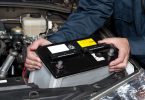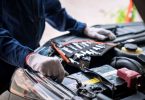Keeping your batteries clean is important for their longevity and function. Batteries use chemical reactions to work. As time goes on, corrosion can occur. If you let this continue, the corrosion will eat into your battery and it will become useless.
Here we’ll be showing you some ways to clean your battery terminals to keep it running at its best.
How to Clean Battery Terminals Without Baking Soda?
One of the most popular ways of cleaning battery terminals is to use baking soda. There are many other, better and faster options to clean your battery. Many of these methods use items that are probably sitting in your kitchen.
Method 1: Hot Water
Pouring water on a battery may seem like a death wish, but car batteries have lots of sealants and plastic cover to protect the batter from water. This method is simple, fast, and almost free of cost.
Step 1: Grab a small cup of hot water. It doesn’t have to be boiling, but it should be steaming.
Step 2: Pour the water over the corrosion.
Step 3: When the corrosion is completely washed away, dry any excess water.
Method 2: Coke
Water is useful, but the chemicals present in Coke have proven to be great rust and corrosion removers. It is more thorough than the water method..
Step 1: You will need a small bottle of Coke, a small container that your terminals can fit in, a rag, and a screwdriver.
Step 2: Detach the terminals from the battery and remove the battery from the car.
Step 3: Use your screwdriver to get all the big spots of corrosion from the terminals.
Step 4: Pour some Coke into the container and set your terminals in the Coke for five to ten minutes.
Step 5: Remove your terminals from the coke and dry them. All corrosion on the terminals should be gone.
Step 6: For any corrosion that’s left on your battery, pour some Coke on your battery and let it sit for ten seconds.
Step 7: Dry any excess Coke from your battery and re-place in your car.
Method 3: Battery Foaming Cleaner
If you want your terminals to be cleaned thoroughly and safely, a can of battery foam cleaner will be your best option. You can find battery foam cleaner at any hardware or auto parts store.
Step 1: For this method, you’ll need a can of battery foam cleaner, a steel brush, a hose, and a rag.
Step 2: Remove the battery from the car.
Step 3: Spray the foam cleaner on the terminals. Let it sit until it starts to fall off.
Step 4: Spray another coat of the cleaner, then wait for the cleaner to do its work.
Step 5: Use your steel brush to scrape off any loose bits on the terminals.
Step 6: Apply a third coat of the cleaner, then scrub the terminals again.
Step 7: Use your hose to spray off any stubborn corrosion that’s still stuck on. The pressure should be strong, but don’t use a high-pressure hose like a pressure cleaner.
Step 8: Dry your terminals with your rag.
Method 4: Vinegar
Vinegar is another easily accessible household acid that you can use to clear away that pesky battery corrosion on your terminals. Here’s how to use vinegar to clean your battery terminals.
Step 1: Get some white vinegar. You can use a spray bottle or just pour it on. A spray bottle keeps things clean.
Step 2: Remove the terminal covers.
Step 3: Apply the vinegar to the terminals. It will eat away corrosion almost instantly.
Step 4: Wipe away any excess vinegar.
Method 5: Lemon
Lemon juice also has acidic properties making it a good way to clean away corrosion. Head to the kitchen, then follow these steps.
Step 1: Cut a lemon in half and grab a handful of paper towels.
Step 2: Detach the terminals from the battery.
Step 3: Squeeze the lemon juice on the corrosion.
Step 4: Use the paper towels to wipe away any excess.
Method 6: Brass or Stainless-Steel Brush
Sometimes, elbow grease is the best solution. A metal brush is rough and stiff that gives it a strong scrubbing power. Battery corrosion can be scraped off with the right tools.
Step 1: In this method, you will need just a brush.
Step 2: Disconnect the terminal cables.
Step 3: Use the stainless-steel brush to brush off any corrosion or oxidation.
Step 4: Add some oxidation resistant oil to the terminals.
Step 5: Reconnect the cables.
Things to Remember While Cleaning the Battery Terminals
- Always wear the right protective gear. You’ll want gear made from materials that don’t conduct electricity.
- Don’t wear jewelry while you are working. Some metals, especially gold and silver, are conductors that let electricity flow through them. This can cause some serious damage to you.
- Never allow the positive and negative terminals to cross. This can cause your battery to explode.
- When removing terminals, always the take the negative off first and put it back on last. This will reduce the chance of a short circuit if something touches the battery.
- Keep some warm water nearby to rinse off any chemicals that may get on you. If this happens, wash the whole area for at least 15 minutes.
FAQs
1. What causes buildup on battery terminals?
Ans. Chemical reactions produce waste after they happen. The buildup on your battery terminals is the byproduct of all the reactions that happen for a battery to work.
2. Can battery corrosion keep my car from starting or even drain the battery?
Ans. Yes, it can cause many issues with your battery. As the buildup grows, it will create spaces between the terminals and the battery, reducing the energy transfer between the engine and the battery.
3. Can I use WD-40 on my car battery terminals?
Ans. Using WD-40 is not recommended for two main reasons. WD-40 is a solvent, which means it will remove any seals or oils on your car parts. These seals and oils protect your engine. Removing them makes your engine extremely unsafe.
The second reason using WD-40 is bad is because it is not conductive. If you spray it on your battery, it can reduce conductivity between your battery and the terminals. Without conductivity, your battery will not charge.










Leave a Comment